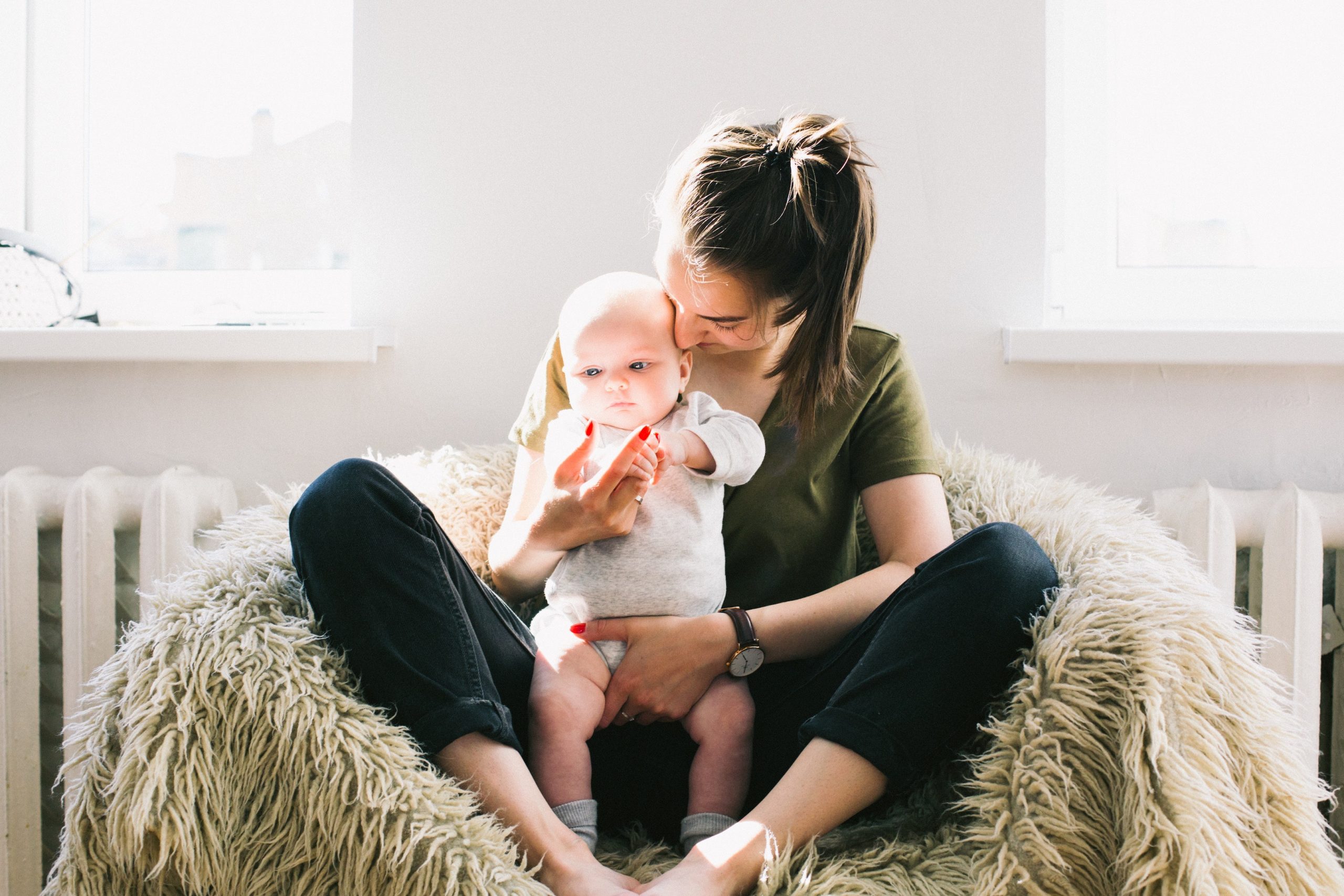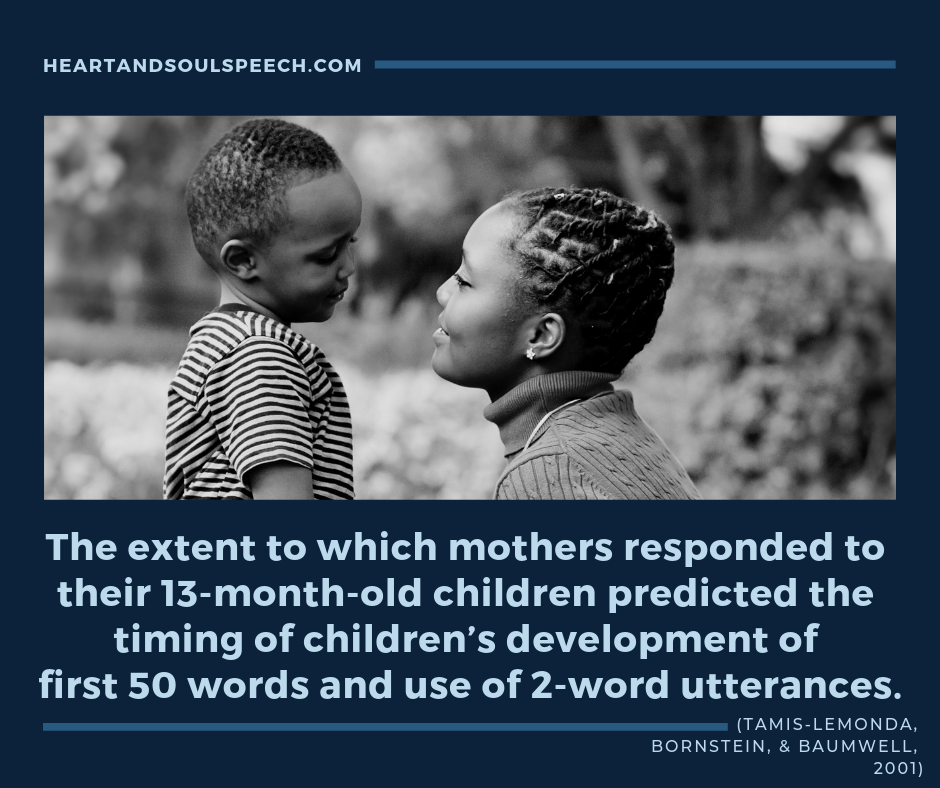I recently visited a friend with a newborn baby. As I sat and listened to his beautiful story of the first few weeks of his baby’s life, I remembered my first days as a first-time parent. The exuberant joy. The overflowing love. The exhaustion. The adrenaline. The anxiety. The awe. The feeling that you actually have a tiny human that’s yours to love.
Those first weeks can be tough trying to anticipate your baby’s needs. Learning how my son told us what he needed were some of the most wonderful, yet also confusing times for me. It’s so easy to forget to listen to their tiny voice when you’re sleep deprived, adjusting, and full of self-doubt. As we began to trust each other – my son trusting us to meet his needs, and us learning to trust his communication – our relationship flourished and I began feeling more confident as his mother.

How do babies communicate?
Some people may not realize speech-language pathologists work with infants and toddlers. “But babies don’t talk yet!” True–babies don’t use words yet, but they tell us so much through their behaviors! Crying, cooing, looking -they all have a purpose in an infant’s communication. When caregivers are able to recognize and respond to their baby’s cues, they are laying the foundation for language development.
As toddlers begin to produce words, it becomes easier to understand and meet their needs. However, infants tell us so much through their behaviors as well. When a newborn is already crying, we’ve likely missed the signs that were communicated leading up to that point. The baby is already dysregulated and less able to receive our response. With newborns and babies, communication may be subtle and require more interpretation. To connect and communicate with a newborn, we need to anticipate and observe. We truly must tune in to each behavior as a sign that tells us what to do.
Why does it matter?
Research shows caregivers’ responsiveness is a major key to language growth. In one study, the extent to which mothers imitated their 13-month-old child predicted the timing of the child’s later language milestones (Tamis-LeMonda, Bornstein, & Baumwell, 2001). Just expanding on the child’s speech attempts can increase the child’s development of their first 50 words and use of two-word combinations. For example, a child says “Ba!” and the mother responds with “Ball!” In younger infants, caregivers can imitate facial expressions and gestures like smiling, yawning, or pointing to increase their readiness for language.
Interestingly, this study showed that how often a mother initiated a conversation with her child was not predictive of language growth, but that the most significant factor was the mother’s response following the child’s initiation.

Recognizing baby communication
Newborn infants use crying as their first form of communication. Generally, a baby’s cry tells us they need something. As you learn more about your baby, you may notice different types of cries: “I’m hungry or wet” may be short and low-pitched; “I’m mad or tired” may be choppy and higher-pitched. Babies also get easily overwhelmed by their new environment, trying hard to process the new sights and sounds. It’s not always easy to interpret their cries, but your comfort can help babies feel more secure. Babies cannot be spoiled with too much attention. Your response is how babies learn to better communicate their needs.
As babies develop, they learn how to use more behaviors that communicate more clearly.
1 to 3 months
- Typically, babies begin to use effective eye contact between 6-10 weeks of age and are able to follow movements farther away around 3 months.
- Babies start smiling to communicate between 8-12 weeks of age.
- They love the sound of your voice and may get quiet or excited and move around when they hear you.
- Cooing and gurgling starts around 2 months of age, which caregivers can imitate and repeat to promote language.
4 to 7 months
- Babies now know they can communicate to get a response from their caregivers. They are babbling more and like to watch their parents’ faces.
- They start to experiment more with their sounds, pitches, and intonation.
8 to 12 months
- Babies will begin taking turns babbling with you, sounding more like an adult conversation.
- They like trying to imitate the new sounds you make.
- Babies may produce their first words at this age.
Responding to baby communication
When we respond to our baby’s communication, we teach them we are listening. All humans want to be heard, including babies. Using these strategies will provide a language-enriched environment for your child at home.
-
Pay close attention to your baby’s behavior
Learn your baby’s cues and respond to them as much as possible. Again, research supports caregivers’ responsiveness is the key to language!
-
Smile and make eye contact with your baby
Look at your baby while she coos, babbles, and laughs. Eye contact encourages the baby to continue interacting with you. Babies understand pitch and tone before words, so by smiling and using a welcoming tone you teach your baby how to change their voice when babbling and understand different tones.
-
Imitate your baby
It may feel odd to do the same things as your baby, especially when the ultimate goal is your baby imitating you. However, when you imitate the baby’s actions or coos it starts teaching turn-taking and conversational rules. It doesn’t matter what sounds the baby is making, just do your best to match their facial expressions and sounds. Use a mirror to help the baby see his own face and your face. This is so fun for babies!
-
Talk to your baby
Again, it may feel funny to talk to a little human who isn’t talking back, but babies love to hear you talk. Babies learn to speak by imitating sounds they hear around them. Talk about your day, narrating what you’re doing in the kitchen, while doing laundry, etc. Repeat common vocabulary often during your routines and connect the word to the object.
-
Read together & sing to your baby
Interactive reading with babies may not be a natural skill for parents, but it’s easy to learn! Babies like to listen to you read the story, but also want to be involved with the book. Point to pictures, name objects, and allow for your child to engage with the book. Take a look at this example of interactive reading with young children.
Patty-cake and peek-a-boo are fun games that allow for turn-taking and interaction. Songs allow for gestures and repetition, which is great for language. Pre-literacy skills, such as rhyming, alliteration, and syllable counting can be taught through songs.
How should I talk to my baby?
- Parentese is a grammatically correct speech style that uses elongated vowels and exaggerated tones in a happy tone, but avoid the duplication, rhyming, or nonsense words (Ramirez, Lytle, Fish, & Kuhl, 2018). Research shows this is the most effective way to teach language to young children.
- Baby talk uses simplified speech, often presented in a high-pitch voice. Examples of baby talk include “choo-choo” instead of train, “wa-wa” instead of water, or “milky” instead of milk.
- Telegraphic speech only uses content words with little or no grammar. Examples of telegraphic speech would be “Where shoes?” instead of “Where’s your shoes?” or “Mama cup” instead of “This is mama’s cup.” Research shows this type of speech can actually delay a child’s understanding of correct grammar and vocabulary.
A recent study showed caregivers who use parentese (instead of baby talk or telegraphic speech) promote growth in infant babbling between 6 and 14 months of age (Ramirez, Lytle, Fish, & Kuhl, 2018). Babies respond well to a slightly slower rate of speech, simple vocabulary, lots of repetition, emphasis on important words, and an exaggerated positive facial expression. Therefore, using parentese allows infants to understand more vocabulary and learn more meaningful interactions with others.
Do baby flashcards and videos help with language development?
These “educational” products available are not particularly effective in helping children learn how to communicate. Research has not provided evidence these produce better language skills, and one study showed popular baby DVDs may actually slow down language development in infants ages 8-16 months of age (University of Washington, 2007). A child learns language through hearing vocabulary and grammar modeled by caregivers in meaningful contexts—so don’t watch, just talk!
Does using a pacifier cause speech and language problems?
We don’t know. Prolonged pacifier use has been linked to dental problems and increased ear infections, both of which can have a negative impact on speech and language development. However, we can assume that a child’s opportunity for practice babbling, imitating sounds, and engaging in conversation is more limited if there is a pacifier in the mouth.
A Note on Newborn Sleep & Communication
Every parent of a newborn gets asked “Is he sleeping through the night yet?” Oh, how our society has pressured babies to fit into our schedule so fast! When we buy into this perception, we don’t stop to consider what the baby is communicating to us by waking in the night. By crying. By not eating well. I get it–it’s really hard. Really, really hard. I need sleep too. But when an infant depends on you to meet their needs, and uses their behaviors to communicate with you, we must help them in their development by responding with connection instead of forcing change.
Babies only want to be just like you! How do you teach your baby language? How does your baby communicate with you?
If you want to learn more about speech and language development, read more about what parents need to know!
Ramírez, N. F., Lytle, S. R., Fish, M., & Kuhl, P. K. (2018, November 26). Parent coaching at 6 and 10 months improves language outcomes at 14 months: A randomized controlled trial. Retrieved from https://onlinelibrary.wiley.com/doi/abs/10.1111/desc.12762
Tamis-LeMonda, C. S., Bornstein, M. H., & Baumwell, L. (2001). Maternal responsiveness and children’s achievement of language milestones. Child Development, 72, 748–767.
University of Washington. (2007, August 7). Baby DVDs, Videos May Hinder, Not Help, Infants’ Language Development. Retrieved from http://www.washington.edu/alumni/uwnewslinks/200709/videos.html

I enjoyed this so much! Parentese has always been natural for me, but all too often I hear, “talk in a normal voice not baby talk, I heard that was good”.
Also, great information on Telegraphic speech! Sometimes I don’t realize I shorten my sentences in an ungrammatical manner.
Yay for starting first foods…. and first words!
We swore we heard dada the other day by accident.
Thank you! I’m happy you’re using parentese to communicate with your sweet little one! First words are SO exciting!!